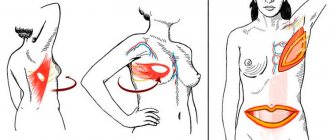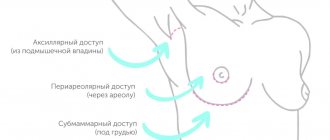Breast asymmetry is a congenital or acquired difference in the volume, shape or location of the breast.
The term breast underdevelopment is sometimes used. Underdevelopment can affect both one gland in relation to another, and individual parts of one gland. Breast tubularity is precisely the underdevelopment of part of the mammary gland. We can distinguish underdevelopment of the lower, upper, lateral and medial slopes. General underdevelopment of this type forms the classic tubular breast: a narrow base and a cylindrical shape of the breast itself.
Asymmetry of the areola or nipples. Areolas can form in different diameters and shapes. The nipples can vary significantly in the degree to which they bulge forward. An extreme case is an inverted nipple or inverted nipples.
Causes of breast asymmetry
- Features of breast development. Developmental features in childhood and adolescence can lead to breast asymmetry. This is probably due to unaccounted for trauma to the mammary gland area.
- Heredity. It can be assumed that breast asymmetry is associated with heredity, but evidence for this has not yet been found.
- Age-related changes . Asymmetry in the process of involution of the mammary glands can increase due to a general decrease in volume, but cannot occur without objective reasons.
- Pregnancy and lactation . Asymmetry appears in the case of “asymmetrical” feeding, when one of the breasts is “used” more and lactates more. This asymmetry subsequently decreases, but does not disappear completely.
- Surgical intervention. Asymmetry can be caused by operations performed in childhood or adolescence in the chest area. Removal of mammary glands, removal of part of the mammary gland, or removal of a tumor are the most common reasons for seeking treatment for asymmetry correction.
- Neoplasms in the breast. Tumor growth can lead to enlargement of one breast. Such tumors can be benign or malignant
- Scoliosis. Curvature of the spine, leading to a lateral tilt of the body and, as a consequence, visual asymmetry of the breast, when one breast looks lower than the other.
What is the degree of breast asymmetry?
- weak (type 1): causes are unilateral micromastia (lack of volume in one breast) and skin ptosis, therefore, surgical intervention is not required;
- medium (2nd type): with this degree, the help of a surgeon is needed, namely, a procedure for excision of a certain part of the mammary gland is required;
- strong (type 3): in this case there is a very noticeable difference in the size of the mammary glands, often one is 2 times larger than the other.
Any breast adjustments are usually carried out for medical reasons, in particular if it disrupts posture and causes other physiological changes that are completely undesirable for the body.
What is correction of breast asymmetry (correction of asymmetry of the breast, mammary glands)?
Breast asymmetry surgery is a procedure that reduces differences between breasts. Minor differences between the breasts are normal, but if these differences cause significant concern, then breast correction is performed.
Depending on the difference between your mammary glands and individual characteristics, there are several correction options:
- enlarge smaller breasts (breast augmentation)
- enlarge or reduce both breasts to varying degrees
- lift sagging breasts (breast lift).
Different breasts: how to fix them
Surgeries aimed at correcting breasts of different sizes may include one of the following procedures or a combination of them:
- breast augmentation using lipofilling or silicone implants;
- breast reduction;
- mastopexy (breast lift).
Different breasts reviews
“By the age of 37, I decided that it was time to change my life and rescue my two girls from prison. My girls, already former beauties, sitting in captivity and not seeing the white light, became depressed, limp and sagging. The former captives and I urgently needed to be cheered up and in shape. There was only one way to cheer up - surgery. The search for options for a surgical solution to the problem led me to the fact that I am now writing a review about a vertical breast lift, which turned out to be life-saving for me. I had surgery in St. Petersburg with one of the leading plastic surgeons in Russia, Levitskaya Maria Grigorievna” Tatyana, 38 years old and other reviews about mammoplasty.
Depending on the complexity of the problem, namely the degree of difference in the size and shape of the breast, one or another method of performing the operation is selected. But much more often they are a combination. For example, one mammary gland is enlarged with lipofilling or a silicone implant, and the shape of the second is symmetrized using a breast lift.
If there is a slight difference in volume, you can add volume only to the smaller breast or enlarge both mammary glands by installing implants of different sizes and shapes. It all depends on the wishes of the woman and her anatomical features.
Is breast asymmetry correction right for me?
Surgery to correct breast asymmetry is a highly individual procedure and may not be suitable for everyone. You should always consult your plastic surgeon to make your decision. He will assess your health and create a treatment plan that is suitable for you personally.
Before deciding on surgery to correct breast asymmetry, there are some important questions to keep in mind:
Surgery to correct breast asymmetry will reduce the difference between your breasts at the time of surgery. However, breasts tend to change shape and volume over time, which may require additional correction in the future. The likelihood of having a breast implant replaced is small, but the possibility is present.
Although breasts of any size can be lifted, women with heavy breasts may not experience long-lasting results.
Before performing surgery to correct breast asymmetry, surgeons usually recommend waiting until breast development, pregnancy and breastfeeding have stopped - however, if the difference is large, then surgery can be performed starting at age 18.
Smokers are at increased risk of complications after any surgery. This also applies to the correction of breast asymmetry. If you are serious about plastic surgery, try to quit smoking or significantly reduce your smoking before surgery.
If you are concerned about the way you look or are thinking about cosmetic procedures to boost your self-confidence, then there is no alternative to cosmetic surgery. Alternative treatments may include different padding, wearing padded bras, or accepting who you are.
Correcting breast asymmetry may be a good option for you if you:
- Physically healthy
- You have realistic expectations
- Your breasts are fully developed
- Your breasts vary significantly in size (especially if the difference is more than one cup).
- Your breasts vary significantly in shape, i.e. one of them sags, has lost its shape and elasticity compared to the other.
- One breast is lower than the other
Remember that the shape and size of your breasts before surgery will influence the type of surgery and its outcome.
Breast asymmetry - symptoms and treatment
Most cases of asymmetry do not require any special treatment. In patients with severe psychosocial disorders due to asymmetry of the mammary glands, there are 3 options for correcting the pathology and the psychosocial complications caused by it.
Method 1 - non-medical correction of mammary gland asymmetry. For minor asymmetry, a padded bra cup or a special silicone pad over the smaller breast can eliminate the visual consequences. When looking for a bra, the main thing to remember is that the cups should fit comfortably over larger breasts, not smaller ones. Then the cup and the bone will not squeeze the large mammary gland.
Method 2 - non-surgical correction of mammary gland asymmetry. Elimination of breast asymmetry is possible without surgical techniques using alternative methods if the patient has minor asymmetry. These methods include non-surgical procedures (hyaluronic injections, lipofilling), which are also performed by a plastic surgeon. Despite the fact that they provide only a temporary effect, many patients choose them.
Hyaluronic injections. Enlargement of a smaller mammary gland to achieve symmetry by placing fillers based on hyaluronic acid. Fillers are injected into predetermined areas of the mammary gland, which allows you to fill the missing volume, perform a slight correction of 1st degree asymmetry and slightly change the shape of the mammary gland.
Breast lipofilling. The technique is based on the use of the patient’s own fat tissue. The procedure involves taking adipose tissue from those areas of the body where it is present in excess, and transposing it to the mammary gland that needs volume replenishment to eliminate asymmetry.
Method 3 - surgical correction of mammary gland asymmetry. The key to successful correction is to find out which breast the patient prefers. Such women, as a rule, do not strive to have large breasts. These patients do not tend to evaluate their breast size at all - they just want to be normal, which means having two breasts that look the same. This goal can be achieved with surgery on one mammary gland, but it is better and more correct to perform surgery on both mammary glands. It is important to explain the reason for bilateral surgery to the patient and her relatives. It is critical that they understand the concept: the more similar the procedures performed on each breast, the more likely it is that symmetry will occur and that it will last.
These patients are more susceptible to breast scarring than patients undergoing purely aesthetic surgical procedures.
There are no rules or guidelines regarding the optimal age for this elective surgery. To be sure that breast growth is complete, it is best to advise the patient to wait until she reaches the age of final puberty. However, there are many patients for whom such a delay would be too much of a psychological burden. In this case, surgery is suggested with the explanation that more precise breast correction may be required later. Maintaining a symmetrical result over time, especially with the changes in size and shape that naturally occur during pregnancy, lactation or weight changes, is challenging. However, it is not worth postponing correction until the functional activity of the mammary gland is complete if the patient has severe psychosocial disorders.
Each patient with breast asymmetry is unique, but standard aesthetic surgeries are used to achieve symmetry: augmentation, mastopexy (lift), reduction (shrinking) of the breast, and combinations such as augmentation/mastopexy or reduction/augmentation. Asymmetrical correction may include the placement of two implants of different sizes with different filling volumes and different profiles.
A breast lift or reduction can be performed using any technique that the surgeon deems reliable.
Basic rules for surgical correction of mammary gland asymmetry:
- Find out from the patient which breast she prefers.
- Only perform surgery if the patient is experiencing severe psychosocial problems.
- The operation begins with the larger mammary gland.
- The more similar the operations on the mammary glands, the longer the result.
Contraindications to surgery for breast asymmetry
There is a standard list of restrictions for any plastic surgery.
- The operation is not performed in the presence of any chronic diseases in the decompensation stage.
- Correction of asymmetry of the mammary glands is not carried out during pregnancy and breastfeeding.
- The operation can be scheduled no earlier than six months after the end of lactation.
Preparation for surgery for breast asymmetry
First, the surgeon conducts a consultation. The patient’s requirements for new mammary glands are determined, the types of surgery are selected together with the patient, and implants are selected if necessary. Before surgery, a woman should also consult with an oncologist (or better yet, the operating surgeon is an oncologist) and an anesthesiologist. It is also necessary to undergo tests, have a mammogram, ultrasound or MRI of the breast (as indicated). Before surgery, remove hair in the armpits, and on the day of surgery, do not eat or drink anything in the morning. Without getting out of bed, put on compression stockings of the 1st degree of compression to prevent thromboembolism.
Do I need anesthesia to correct breast asymmetry?
Yes, surgery to correct breast asymmetry requires either general or local anesthesia. Modern anesthesia is safe and effective, but has some risks. They are small and do not pose a threat to health or life. Basically, we should talk about the inevitable consequences of the operation, which cannot be prevented, but can be expected and mild. This can be discussed with your surgeon or anesthesiologist. Adaptive anesthesia , which we have been using for many years in our work, is the optimal choice for breast surgery. With adaptive anesthesia, the anesthesiologist provides shallow sleep, but sufficient for comfort, and the surgeon provides pain relief to the surgical area. This allows you to make the operation comfortable, safe and without pain after waking up. There are no side effects from adaptive anesthesia. Waking up without any consequences. The risks of anesthesia are minimal. Adaptive anesthesia allows you to go home the same day, which is acceptable for some breast surgeries.
Preparing for surgery
Changing the shape and size of the breast requires preparation:
- Taking tests. It is necessary to do standard laboratory tests of urine and blood, as well as ultrasound of the mammary glands. Plus, it is necessary to exclude all the contraindications mentioned above.
- Choice of methodology. The patient and the surgeon discuss the desired result, the doctor assesses the situation and gives professional recommendations.
- Preparation period. Two weeks before the intervention, you should avoid taking alcohol, strong drugs (if possible), hormones and drugs that affect blood clotting. You must not eat or eat on the day of the procedure.
It is also important that the operation is not performed at the beginning of the menstrual cycle.
What are the potential risks and complications?
Modern surgery is generally safe, but potential risks always exist. Some of the problems associated with surgery to correct breast asymmetry may include:
- bleeding or infection
- seromas and hematomas
- noticeable scars due to stretching and lengthening
- noticeable scars due to keloidosis
- allergic reactions to medications, patches and suture material
- pigmentation or skin lightening
- impaired blood supply to the skin and necrosis
- impaired sensitivity of gland areas
- impaired sensitivity of the nipples and areolas
- unevenness and ripples above the implant
- capsular contracture (fibrous capsule around the implant)
- unsuitable implant size
- implant rupture
- inability to breastfeed
In what cases is re-plasty recommended?
Repeated mammoplasty is performed at the request of the patient or for direct indications. In the first case, the woman is not satisfied with the aesthetic result; she wants to change the shape, make her breasts larger or smaller than during the first operation. In the second case, patients turn to a plastic surgeon due to complications associated with previous operations, as a result of which the mammary glands became deformed and lost their desired appearance. The main indications for which mammoplasty is repeated:
- breast asymmetry after mammoplasty (asymmetry of glands or areolas);
- displacement of implants beyond the gland area and protrusion of their contours;
- prolapse of the mammary glands below the implant (so-called “ptosis”);
- rupture of the implant due to its poor quality or mechanical damage;
- cicatricial deformation, or contracture of the implant - the formation of a capsule of dense fibrous tissue that surrounds the implant, compresses and deforms it, changing the shape of the gland;
- rough, unaesthetic scars from previous operations, including oncological ones;
- loss of shape, elasticity, asymmetry of the breast after mammoplasty in the long-term period.
Revision breast surgery is performed by Dr. Mistakopoulou. Philip Nikolaevich is an experienced reconstructive plastic surgeon. He performs corrective surgeries for all the complications described above, helps to get rid of imperfections and achieve a beautiful breast shape.
What other implant-related issues should I consider?
There are claims that breast implants are associated with the development of connective tissue diseases such as rheumatoid arthritis, SLE (lupus erythematosus), scleroderma and similar autoimmune conditions. Although some studies suggest an increased risk, most medical studies have shown that implants do not increase the risk of these problems. Breast implants do not increase the risk of breast cancer. If breast cancer is detected in women with prosthetic breasts, then, as a rule, the recovery rate is higher in the early stages. This is due to these women taking more careful care of their health.
Will correcting breast asymmetry affect my ability to breastfeed?
Cases may vary, but in general, mothers can breastfeed after breast asymmetry is corrected. However, for some women, after surgery to correct breast asymmetry, sensation in the nipples is reduced, making it more difficult to trigger the reflex that causes milk to come down. Some women may also experience a decrease in milk supply. If you plan to breastfeed after surgery to correct breast asymmetry, talk to your plastic surgeon to get information directly about your surgery.
What should I do after breast asymmetry correction surgery?
At the end of the operation, bandages are applied to the wounds, and in case of breast replacement, compression garments are applied. Breast lifts require a supportive bra or top.
Initial recovery will take time, but after 2-3 days you can begin moderate physical activity. By the second week, return to your normal rhythm, and by a month after correction of breast asymmetry, gradually return to sports. In the first weeks, avoid heavy lifting, strenuous exercise, swimming and intense sports.
If you have any of the following symptoms, notify your surgeon immediately:
- Temperature above 38°C or chills
- Heavy bleeding from incisions
- Redness around incision sites
- Increased pain or swelling after it goes away
Your surgeon will give you specific post-operative care instructions. These instructions will include:
-Daily shower and treatment of seams with an alcohol antiseptic.
-Analgesics if necessary
- Limiting physical activity in the first days
What is the cost of breast asymmetry correction?
The correction can be divided into possible options.
One breast lift.
Breast lift on both sides.
Prosthetics of one breast and lift of the other.
Prosthetics of two mammary glands with different implants with or without lifting
Correction of the position or shape of the areola and nipple
Decreasing or increasing the inframammary fold.
When correcting breast asymmetry, it is very difficult to determine in advance or in absentia the type of operation required or a combination of these operations. Any asymmetry is a non-standard situation and the approach must be individual. Based on the totality of actions, you can create a list of services and determine the cost. If the actions are performed on one side, then the cost of the operation is lower.
In Moscow, the cost of prosthetics for one breast is in the range of 150-250 rubles.
— the cost of a breast lift is in the range of 50-150 rubles.
— the cost of prosthetics and breast lift for one breast is in the range of 150-350 rubles.
— the cost of prosthetics with correction of tubular breasts is in the range of 150-450 rubles. — the cost of correcting the shape of the areola (unilateral or bilateral circular mastopexy 50-200 rubles.
— the cost of correcting an inverted nipple (one-sided or two-sided) is 50-100 rubles.
In Russia, the cost of surgical correction of breast asymmetry depends on the city, medical center, training and ambitions of the specialist. The price range can be huge, as can the correctness of the chosen treatment.
Correction of tubular breasts occupies a special place in the topic of breast asymmetry correction in Russia. This is a narrow topic that most surgeons either do not encounter, or unsuccessfully and unsuccessfully try to deal with according to their personal understanding, using proprietary techniques and “new approaches.”
Types of breast asymmetry and their correction
In medicine, a violation of breast symmetry in women is often encountered. Most of the defects can be corrected exclusively by surgery. All breast correction operations are performed under general anesthesia and last from 1.5 to 4 hours.
Below are the types of breast asymmetry that can be corrected using mammoplasty:
- hypoplasia (underdevelopment) of one mammary gland with a normally developed second. As a rule, this pathology has genetic causes. In this case, it is recommended to enlarge the smaller gland with a silicone endoprosthesis;
- hypertrophy (strong enlargement of one of the mammary glands). The second mammary gland is absolutely normal and does not require treatment. The development of this anomaly is also influenced by a genetic factor. In this situation, the doctor performs reduction mammoplasty or reducing the size of the hypertrophied breast;
- prolapse (ptosis) of one mammary gland while the other is in a normal position. If the breast volume is not too large, then the correction consists of lifting sagging breasts through an incision in the areola area;
- If there is asymmetry in the size of the nipple areola, the size of the areola is changed. The incisions that will be made during the operation can be used for further breast augmentation;
- if asymmetry manifests itself in the form of different shapes and sizes of nipples, the doctor reduces the diameter of the larger nipple, comparing it with the size of the smaller one, and corrects its shape;
- hypertrophy of one gland and prolapse of the other. Most often in this situation, reduction mammoplasty of one breast and lift of the other are recommended;
- the presence of asymmetric ptosis of the mammary glands and differences in their size. During the operation, the specialist performs mastopexy of both mammary glands. If the breast size is no more than C, the surgeon can enlarge the smaller gland or enlarge both, but using implants of different sizes;
- This type of disproportion is very common, such as the tubular form and the small size of one mammary gland. The tubular form of the breast is a structure in which the mammary gland resembles an elongated proboscis. This defect is eliminated by installing a prosthesis under the glandular tissue of the smaller mammary gland. After this, the posterior wall of the breast capsule in the projection of the areola is dissected;
- hypertrophied tubular form of one of the glands. Correction of breast asymmetry in this case involves reduction mammoplasty;
- hypertrophy of one breast and hypotrophy or small size of the other. As a rule, this anomaly is caused by genetic reasons. The operation is performed on both mammary glands. During the procedure, the smaller gland is enlarged and the larger one is reduced;
- tubular form of both mammary glands. Even if they are approximately the same in volume, it is recommended to correct the shape of the breast. Correction of the shape of the tubular breast is carried out without the use of an endoprosthesis.
The cost of breast correction surgeries in our clinic.
The cost is formed according to the basic price list for a specific operation. The cost of a breast lift or prosthesis for one breast is usually 2/3 of the cost of a bilateral operation. The cost of the implant is discussed separately and depends on the manufacturer. In recent months, due to strong changes in the ruble exchange rate, prices for implants and other foreign materials have increased significantly in price, which has led to an increase in the cost of treatment.
In the clinic’s price list, the cost of any operation is presented in the price range from... to...
The spread is quite wide and affects the upper part of the low price range, the middle and high price categories. The purpose of this proposal is to provide the opportunity for anyone who wishes to undergo treatment. All the clinic’s specialists dealing with breast problems have sufficient training and experience, are well versed in the topic and can be recommended by me without fear. The distribution of surgeons into price categories is not a matter of quality or safety, which are equally high, but a matter of my personal decision. Therefore, the patient can safely choose a surgeon according to his liking or his personal preferences. In any case, the entire treatment process is under my control, and you can contact me personally at any time.
Questions
I have a complex because of my breasts. I can't figure out what's wrong with her. Maybe it is tubular and can be made normal? What do you advise?
— If the breast is tubular, then there are methods to correct it. You can send a photo, go on video call or come for a consultation. Let's discuss all possible options. If you have a complex about your breasts, and probably for a long time, then without correcting the shape of your breasts, this complex cannot be overcome. After correction, it will disappear on its own.
Since my youth, one breast was slightly larger than the other. They said that by the age of 20 everything would get better. After taking oral contraceptives, it feels like it has become bigger and saggy. The color of the areolas has changed. Can I come to you for a consultation with this question?
-Come, of course. I dare to suggest that we will discuss a breast lift, maybe a lift of both mammary glands. We cannot change the color of the areolas. I think that contraceptives have nothing to do with it.
My breasts look like hanging triangles with large different areolas and small nipples. Ugly. Hanging. What can be done about this?
-The areolas can be made the same, the size of the nipples can be increased. From triangles, you can either use a breast lift or a lift with augmentation to form the normal shape of the mammary glands
I am 27 years old married. When I was breastfeeding, he suckled on the right breast, now it is larger than the left. What can be done?
-I think you need to decide which one suits you best. Then discuss reduction of the larger or enlargement of the smaller breast. Both options are acceptable depending on your preference.
I have been operated on 4 times already. They tried to improve the appearance of my breasts. The last doctor said that previous attempts at correction were incorrect and could not, in principle, solve the problem. The chest was narrow, hanging and long. The skin around the areola was excised 2 times, without result. I don’t know what they did at the 3rd operation, but the improvement was no more than 2 months, when it remained swollen and dense. The 4th operation, which took place a year ago, improved the shape, but did not make it attractive. It’s all the same, it’s kind of small, small, nothing. But not as ugly as before. I just want to discuss the increase. Will I be denied due to many previous operations?
-I can assume that the problem of tubular breasts has not been completely solved. Therefore, simply increasing will not lead to satisfaction either. A complete correction of tubularity with implantation is necessary. Previous operations are not a contraindication, but do not make the task easier.









